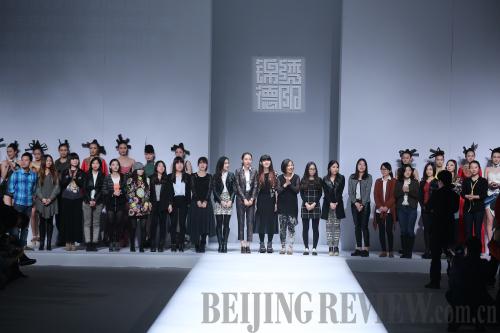|
 |
|
YOUNG BLOOD: Undergraduates from Minzu University of China thank the audience at the Splendid Deyang show on March 27 (COURTESY OF 2013 BEIJING FASHION WEEK) |
To the accompaniment of music, models in bizarre and fancy outfits strutted down the T-stage at Beijing Hotel on March 27. The fashion show, entitled Splendid Deyang Collection, formed part of China Fashion Week Autumn/Winter 2013/2014 Collection held from March 24 to 30.
It reveals glimpses of the ancient while promoting the rich heritage of Deyang. Manifested in color and moveable shapes, it creates a dazzling and mysterious visual treat.
The event represented designs by a group of debuting undergraduates from Beijing-based Minzu University of China with the aim of promoting the development of fashion by focusing on the culture of Deyang, an ancient city in southwest China's Sichuan Province, said organizer Jiang Yanying, a professor in costume design at the university.
She told Beijing Review, "We were inspired by the traditional cultural features of Deyang, which we hope to present via our work."
The city's history dates back 4,000 years to the Bronze Age civilization of the Sanxingdui, the oldest such culture in Chinese history. According to Jiang, the metal texture, green color and bronze pattern of earthen ware found there, alongside Chinese Lunar New Year paintings and Sichuan Opera, became the foundation of their designs.
"Deyang is home to a number of ethnic minorities, including both Qiang and Tibetan, who traditionally wear unique styles of clothing. Our university specializes in the research of minority cultures, which we have a responsibility to promote," said co-organizer Li Jie, deputy director of the costume design group.
According to the director, a total of 21 undergraduates jointly created more than 80 sets of dresses, drawing from their understanding and study of local history and culture.
The show, focused on Exploring the Sanxingdui, Mianzhu New Year Paintings, Charming Sichuan Opera, Story of the Three Kingdoms and Post-Disaster Revival, took nearly a year to prepare, Jiang said.
Because traditional Chinese painting usually depicts ancient figures and cultural icons, many fail to see the link between old cultures and the latest frontier in costume design. Nevertheless, in Mianzhu New Year paintings, the young designers combined patterns and cultural symbols to decorate sleeves, collars and handbags to highlight the special meaning of each unique piece of clothing.
Sichuan Opera, in turn, is famous for its facial contortions and flame spiting, facial makeup differing little from other types of traditional performances. All such elements were incorporated into every design with innovative ideas, most notably by adapting the facial features of widely-known warrior Zhang Fei from the Three Kingdoms period of the third century to fit on a dress.
"It is a good idea to combine traditional facial features with modern design. In this way, designers add a fashionable flavor to old cultural symbols. Moreover, such styles do not lack the connotation of culture," Jiang commented.
The designs expand the fashion limit of traditional folk paintings, Li said.
Yan Mengying, a design senior, told Beijing Review it was her first time presenting designs at an international fashion event.
"I've been preparing since last November. My friends and I have lost count as to how many times we've modified our designs," she said.
Focusing on Post-Disaster Revival, Yan said, "I come from Tangshan in Hebei Province. My home town suffered a devastating earthquake in 1976. Since Deyang itself was hit by an 8.0-magnitude quake in 2008, I can feel the people's pain. However, I wanted to showcase their indomitable spirit."
Looking forward to a career in costume design, she said, "The fashion week gave me the opportunity to show my talents, which will be helpful in finding a good job."
Fellow student Ma Yue, already an old hand at fashion shows, proudly told Beijing Review of her new costume design business in Beijing.
"I registered my own fashion label several months ago," she said.
Ma attributed her success to the supportive policies of both the university and government which, in recent years, have aided graduates in starting their own companies.
"It's a long-time dream come true," Ma said.
Related report:
Fashion Looks East
Email us at: baishi@bjreview.com
| 